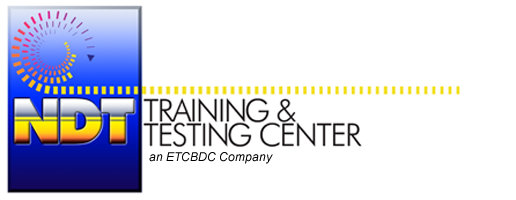Liquid Penetrant Training Overview
Our Liquid Penetrant Training Courses cover all the information you need to prepare for a career in the NDT Industry!
Liquid Penetrant Inspection is basically using a liquid dye to locate surface breaking indications. As a result, only indications or flaws which are open to the surface can be detected and examined with liquid penetrant. So, we use a variety of techniques to achieve our goal.
- Aerosol Spray Cans for Liquid Penetrant, Solvents, and Developers
- Lab set up with dip tanks, etc.
- Automated systems
Primary, we are looking for things like, cracks, lack of fusion in welds, undercut, porosity, etc. However, there are other types of indications. Some indications are specific to certain industries or processes. Therefore, special training is required for the inspector.
Liquid Penetrant Training is important to the quality and safety of materials and structures. Therefore, it can be used on a wide variety of materials. Indications missed during inspection could cause parts to fail. As a result, material failure could result in collapse, explosion, bodily injury or death.
Your job as a liquid penetrant inspector is IMPORTANT! Because, You Keep the World Safe!!
Advantages and Limitations of PT
Advantages
- Liquid Penetrant is fairly inexpensive. Because, Minimal Equipment is required for most applications.
- Liquid Penetrant Training Requirements are easy to achieve
- It can be used on a wide variety of materials, both ferromagnetic and non-ferromagnetic
- And, PT can be used in conjunction with other NDT Inspection Methods
Limitations
- Detects Surface Discontinuities Only
- Quality of vision and training of inspector determines outcome
- Interpretation of discontinuities is dependent on inspector training and experience with specific codes and standards
- Cleaning processes and dwell times for materials
Most Common Uses for Liquid Penetrant Inspection
This inspection method is widely used for Flaw Identification, and Flaw Evaluation in materials and welds. So, let’s take a look at the role of the inspector for each.
Codes and standards are used as guidelines for accepting and rejecting parts. Therefore, Liquid Penetrant Training must include code interpretation. As a result, Organizations like ASME, AWS, API, ASTM, and others develop processes, standards and evaluation criteria for a variety of situations.
Flaw Identification and Evaluation skills are applied to a variety of materials. Therefore, a liquid penetrant inspector must have training to properly identify indications. He or she will also be able to evaluate the indication according to the requirements of appropriate codes and standards. And, be able to accurately measure and document the indications as well.
A properly trained liquid penetrant inspector will have training on interpreting Codes and Standards used in industry. As a result, he/she will be better prepared for a variety of inspection situations.
Liquid Penetrant is in use in a wide variety of industries. So, it is a great career option.
These industries include:
- aviation
- automotive
- welding
- manufacturing
- fabrication
- refineries
- pharmaceuticals
- petroleum
- pipeline, and many more.
Therefore, there are many career opportunities available for the trained liquid penetrant inspector.
Basic PT Techniques
Aerosol Cans
In this case, the PT inspector will use aerosol cans to apply the liquid penetrant dye, solvents and developers using aerosol cans. This makes the test portable. Therefore, liquid penetrant testing can be done in remote locations.
The aerosol can techniques include both water washable and solvent removable penetrant. Also, all of the PT Techniques include both visible and Fluorescent techniques.
Lab Set up
In this case, the liquid penetrant inspector uses a stationary set up. Therefore, dip tanks, drying ovens, air compressors, emulsifiers, and other specialized tools are all used in the inspection process. As a result, Liquid Penetrant Training must include training on these types of equipment.
Automated Systems
In mass production situations like, automotive parts, high volume castings, etc. automated Liquid Penetrant Systems is used. As a result, Liquid Penetrant Training is specific to the equipment. Also, Flaw Detection and Evaluation is similar in all of the PT Techniques.
Liquid Penetrant Inspection Certification Requirements
Currently, the American Society for Nondestructive Testing (ASNT) certification requirements are as follows:
- High School Diploma or equivalent
- 12 Hours of Formal Training in PT Method – Classroom, Online, or Hybrid Learning
- Three Tests – General, Specific, and Practical
*General Test – This is a closed book general knowledge test related to the method being studied.
*Specific Test – This test will test your ability to read, interpret and apply work procedures.
*Practical Test – This is a Hands-On test, which will prove your ability to apply what you have learned.
All tests require a minimum score of 70% to pass the test. But, the Composite Score (average of the three) must be a minimum 80%
- On-the-Job Training or Experience – Documented by company
- 70 hours OJT for Level I
- An Additional 140 hours OJT is required to obtain Level II certification. So, a total of 210 hours of OJT Required
- Annual Vision Acuity and color blindness test
Liquid Penetrant Training
Liquid Penetrant Inspection requires:
- Basic Math Skills
- Knowledge of correct measuring techniques
- Lighting Techniques
- Flaw Identification
- Code Interpretation, and more
So, for your convenience, we offer Classroom PT Courses, Online NDT Courses, and Hybrid Learning Options.
You may also access full course descriptions and additional information related to Liquid Penetrant Inspection by clicking the links below. As always, you can contact us through the links at the top of the page or by calling 713-849-4006.
Explore our Liquid Penetrant Online Course offerings by clicking here
Our Liquid Penetrant Inspection Hybrid Learning Options are the BEST VALUE in the industry! So, Click Here to see what it’s all about.
Take a look at or upcoming Liquid Penetrant Inspection Classroom dates by clicking here.

